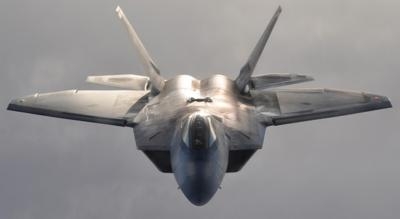Sat, Apr 06, 2013
USAF Says Modifications To Oxygen Systems Have Been Completed Across The Fleet
The F-22 Raptor has resumed normal flight operations after modifications to aircrew life-support equipment were completed across the fleet, including the upper pressure garment and related hoses, valves and connectors. Completion of this task eliminates the need to restrict flight operations to remain within a 30-minute flying distance from an airfield suitable for landing.

F-22 crews have also resumed their aerospace control alert mission in Alaska after the Automatic Back-up Oxygen System was installed in aircraft based at Joint Base Elmendorf-Richardson, Alaska. Altitude restrictions have also been incrementally removed for F-22s that have received the ABOS modification. Altitude restrictions for training flights remain for non-ABOS equipped F-22 aircraft; however, those restrictions will be removed as each aircraft is modified.
The return to normal flight operations hinged on completing eight near-term actions identified by the Air Force Scientific Advisory Board, successful fielding of the modified Combat Edge upper pressure garment valve and fielding of the automatic backup oxygen system. All actions identified by the SAB were completed in December 2012. Fielding of the modified Combat Edge upper pressure garment valve and related pieces was completed in January.
The fielding of the ABOS provides additional protection to F-22 pilots while flying at high altitudes and in the most demanding oxygen-delivery scenarios. The first combat aircraft was modified in January at Nellis AFB, NV. Elmendorf-assigned Raptors began modifications in February and officials expect combat fleet completion by July 2014.

In May 2011, Air Force officials stood-down the F-22 fleet for four months. This operational pause enabled the Air Force to accelerate efforts to study, define and fix the cause of the reported incidents. After the SAB completed its investigative actions in January 2012, the F-22 Life Support Systems Task Force formed a multiservice, multiagency team of government, industry and academic experts to review previous recommendations and findings. This increased breadth of experience, enhanced scope of knowledge, and additional impartial expert analysis led to the conclusion that a lack of oxygen quantity was causing the physiological incidents. The task force also determined the quality of oxygen was not causing the physiological symptoms reported by F-22 pilots and ground crew.
F-22 aircrews have flown more than 22,270 sorties and more than 27,500 hours since the last previously unexplained incident in March 2012. Air Force officials will continue to leverage lessons learned throughout the F-22 investigative process and will invest in characterizing and better understanding the high-performance aircraft environment to improve pilot safety and performance in the F-22 and in all current and future weapon systems.
(Images provided by the USAF)
More News
Also: ANOTHER Illegal Drone, KidVenture Educational Activities, Record Launches, TSA v Shoes The Senate confirmed Bryan Bedford to become the next Administrator of the FAA, in a ne>[...]
Also: Sully v Bedford, Embraer Scholarships, NORAD Intercepts 11, GAMA Thankful Middle Georgia State University will be joining the Federal Aviation Administration’s fight ag>[...]
Also: DarkAero Update, Electric Aircraft Symposium, Updated Instructor Guide, OSH Homebuilts Celebrate The long-awaited Sonex High Wing prototype has flown... the Sonex gang tells >[...]
Also: Sully v Bedford, Embraer Scholarships, NORAD Intercepts 11, GAMA Thankful Middle Georgia State University will be joining the Federal Aviation Administration’s fight ag>[...]
30-Year USCG Veteran Aviator Focusing On Member Benefits The Vertical Aviation International Board of Directors announced its new leadership officers in April, and all began their >[...]
 Airborne 07.11.25: New FAA Boss, New NASA Boss (Kinda), WB57s Over TX
Airborne 07.11.25: New FAA Boss, New NASA Boss (Kinda), WB57s Over TX Airborne-Flight Training 07.10.25: ATC School, Air Race Classic, Samson School
Airborne-Flight Training 07.10.25: ATC School, Air Race Classic, Samson School Airborne Affordable Flyers 07.03.25: Sonex HW, BlackShape Gabriel, PRA Fly-In 25
Airborne Affordable Flyers 07.03.25: Sonex HW, BlackShape Gabriel, PRA Fly-In 25 Airborne-Flight Training 07.10.25: ATC School, Air Race Classic, Samson School
Airborne-Flight Training 07.10.25: ATC School, Air Race Classic, Samson School Rick Kenin New Board Chair of VAI
Rick Kenin New Board Chair of VAI




